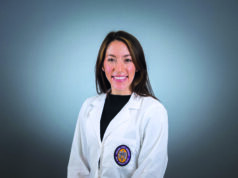
A collaborative effort is needed to establish and adhere to best practice guidelines for radiation safety and exposure, Jasmine Bhinder, MD, a general surgery resident at the University at Buffalo, Buffalo, New York, told attendees of the 2021 Vascular Annual Meeting (VAM) in San Diego (Aug. 18–21) as she presented data from a national survey of vascular surgery residents and fellows in which an “alarming” 25% of trainees reported no feedback on radiation exposure.
The research team, which included Bhinder and colleagues from the University at Buffalo, also found that single hospital programs are more effective at implementing radiation training and feedback, and that formal training and monthly exposure feedback are associated with more consistent use of safety practices.
Bhinder relayed the rationale behind the present study: “In our program, it was brought to our attention that a number of residents and fellows had higher than recommended levels of radiation exposure. […] We felt this issue may be a concern at other U.S. institutions, and were curious about the radiation safety practices across the country. So, the objective of this study was to evaluate radiation safety practices among senior vascular surgery residents and fellows across the United States.”
The presenter detailed that the research team sent radiation safety practice surveys to all Accreditation Council for Graduate Medical Education (ACGME) program directors to be distributed to postgraduate year (PGY) four to seven vascular trainees. The survey questions covered program type (single or multiple hospital site), formal radiation training, the use of safety equipment and dosimeters, and frequency of radiation feedback. All responses were recorded electronically and anonymity was maintained, Bhinder informed the audience.
A total of 95 trainees responded to the survey, the speaker revealed, specifying that 55% were from single hospital programs and 45% from multiple hospital programs. “What we found was that trainees from multiple hospital site programs were less likely to meet their radiation officer [21% vs. 71%], less likely to receive formal radiation training [62% vs. 92%] and less likely to receive radiation exposure feedback [53% vs. 92%].”
In addition, the researchers found that a greater percentage of those who received formal radiation training routinely used dosimeters [81% vs. 55%], lead table drapes [59% vs. 15%] and lead shields [59% vs. 15%]. They were also more likely to stand greater than six feet away during digital subtraction angiography (DSA; 81% vs. 52%) and use lower pulse rate adjustments (66% vs. 24%). Bhinder and colleagues found similar results when radiation exposure feedback was provided on a monthly basis and in trainees from single hospital programs compared to multiple hospital site programs.
“This is very important data,” audience member Anil P. Hingorani, MD, clinical professor, in the department of surgery at NYU Grossman School of Medicine, New York, remarked, elaborating, “I think it really highlights the need for standardized training and accreditation for radiation safety across the nation, not only for residents and trainees but also for physicians.” In light of these key findings, Hingorani wanted to know, “How do we get to where we want to go in terms of standardizing the accreditation and safety of our residents and attendings?”
Bhinder responded: “Globally, I think there is nothing in place right now. In our own institution, we have come together and formalized radiation training that is not just available to the trainees but also to the attendings as well. It is provided in a small group setting instead of just via lectures, and so the residents and fellows also have hands-on training at all the facilities, and are able to play with the equipment before actually using it—which I think is important.”
Melissa Kirkwood, MD, chief in the division of vascular and endovascular surgery at UT Southwestern Medical Center in Dallas, commented that radiation safety mandates vary by state, noting, “Our state of Texas mandates seven to eight hours of fluoroscopy training.” Kirkwood also remarked that radiation decreases as trainees progress and get more comfortable. “It would be interesting to send that survey out again later on and see how their dose drops off as they learn these practices,” she added.












